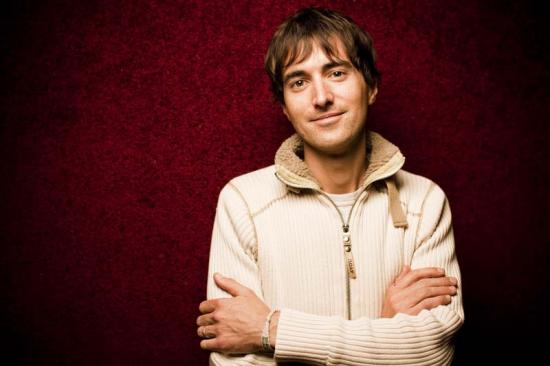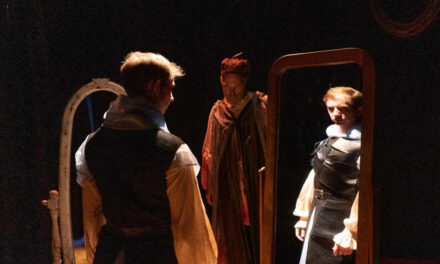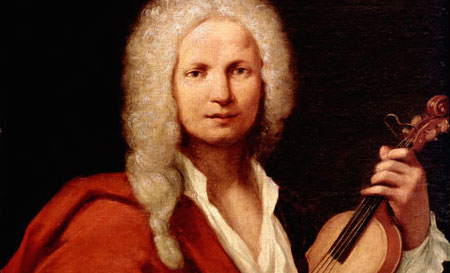Composer Mason Bates. Photo by Todd Rosenberg.
Festival of American Music II
Louisville Orchestra
Teddy Abrams, Conductor
Chase Morrin, Piano
Mason Bates, Electronica
Review by Shaun Kenney
Entire contents are copyright © 2016 Shaun Kenney. All rights reserved.
The April 9 Louisville Orchestra performance was a celebration of American composers, the second of two programs designed to highlight American music across the 20th century and beyond. The evening focused on compositions created within the last 70-75 years, and we were treated to two works that were, at least in part, composed right before our very eyes.
The opening work, the first movement of Harmonielehre by John Adams, was inspired by a dream the composer had in which he saw a supertanker in the San Francisco Bay turn upright and take off into the sky like a rocket. The movement begins with a heavy repetition of an E minor chord, which at first seems simple and minimalistic but quickly turns complex as more instruments join in with varying rhythms and meters. The middle of the movement is much more subtle, almost romantic in nature, while the ending revisits the E minor chord with increased tempo and intensity. The energetic nature of this piece is not only heard but also seen in the powerful bowing of the strings, the dynamic movements in the percussion section, and the grand sweeping gestures of the conductor. It is no wonder Mr. Abrams was out of breath at the final downbeat.
Mason Bates was recently named the second most-performed living composer, second only to John Adams. Bates is known for combining orchestral and electronic dance music. Mothership combines these two genres perfectly. It also relies on the virtuosic talent of several soloists. Bates “imagines the orchestra as a mothership that is ‘docked’ by several visiting soloists.” The solo instruments and their improvisations on the theme can vary from performance to performance. In this incarnation, they were two local musicians: Steve Cooley on banjo and Jacob Duncan on saxophone. I thought the use of the banjo was especially clever, because it brought a piece of Kentucky into the work, making it unique and relevant to the audience. I was also delighted to see the composer himself act as the DJ, performing the electronic aspect of the composition.
Two and a Half Songs – Concerto for Improvising Piano and Orchestra, by Chase Morrin, was its world premiere. Not only had an audience never before heard the piece, but it will more than likely never be heard again, at least not in the exact way it was presented this night. This is due to the fact that for much of the score, the piano solo, performed by Mr. Morrin himself, was improvised on the spot. Mr. Abrams reminded us that although the idea of improvisation may seem modern, it is actually quite old. Many of the most famous composers, Beethoven and Mozart included, were known for their skills at improvisation. Mr. Morrin is no doubt a member of these ranks. The three movements are entitled I. Lively, II. Serene, and III. Fluid and Driving. Although the names are simple, they perfectly describe the mood of each section. I very much enjoyed the performance, and I believe the rest of the audience did as well. There was applause after the first movement, and I heard someone behind me quietly explain to his companion that her applause should wait until the entire work had been performed — to which she replied, “So what? I liked it!” The entire audience shared this sentiment: the performance received a standing ovation at the end of the third movement. Although you won’t be able to hear this particular composition, you can listen to other works by Chase Morrin here:
http://www.chasemorrin.com/#/Recordings
We couldn’t have an evening of American music without a work by Aaron Copland, one of the most iconic composers of the 20th century. His Symphony No. 3 combines his distinctive American style with the form of the European inspired four-movement symphony. The work is inspired by his theme from Fanfare for the Common Man, which can be heard most readily in the fourth movement. Louisville Orchestra’s performance of this work was exquisite, lush, and rich. It too received a much-deserved standing ovation.
This leaves me with one more part of the evening to comment on … perhaps my favorite part. Just before the intermission, I heard a phrase that I believe has never before been uttered as part of a Louisville Orchestra performance. That phrase was, “Please welcome to the stage, DJ GlitterTitz.” Accompanied by the “DJ” (actually Jamey See Tai and Garrett Crabtree), the entire orchestra performed a completely improvised piece based only on chords laid out by Mr. Abrams on an electronic keyboard. It featured several short solos from individual members and was really quite impressive. Imagine giving a speech — a fully fleshed-out speech — on the spot from only a simple outline. Now imagine 45-50 people all doing this at the same time and yet still creating one fully realized and coherent statement. Pretty impressive, right? This performance wasn’t listed as part of the program, which I think was purposeful. After all, what’s more improvisational than performing a piece that the audience didn’t expect? It exhibited the clear talent of every person on the stage and showed, more than any other work of the evening, in my opinion, that the orchestra, specifically this orchestra, is a living, breathing, evolving, and relevant art form.
Festival of American Music II
April 9, 2016
Louisville Orchestra
Kentucky Center for the Performing Arts, Whitney Hall
501 W. Main St
Louisville, KY 40202
www.louisvilleorchestra.org
Shaun Kenney studied Music Education and Instrumental at Campbellsville University. In Louisville, he has worked with Finnigan Productions since its inception as Stage Manager, Sound Designer, and Director.





